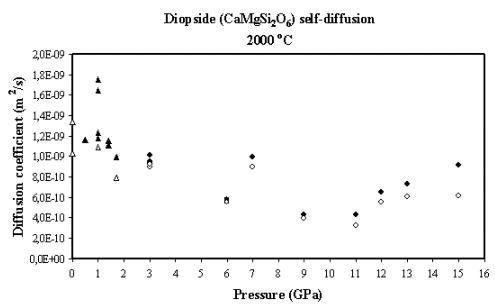

There is an increasing consensus of opinion that a magma ocean of considerable depth (>1000 km) existed in the early Earth. The processes of differentiation during the cooling of such a large magma body would have implications on the resulting geochemical structure of the Earth. For example, the extent of chemical equilibration between the fractionating crystals and magma would depend on rates of crystal settling. An understanding of how pressure affects the rheology of depolymerised silicate melts relevant to the Earth's mantle would allow us to model the convection and rate of crystal settling in a magma ocean. In light of the difficulties of directly determining viscosity at high pressures, particularly for very low viscosity liquids (see preceding contribution), diffusion-viscosity relationships such as the Eyring equation need to be tested for silicate liquids at mantle conditions. Here, the pressure dependence of the self-diffusion of silicon and oxygen in diopside (CaMgSi2O6) liquid over a pressure range from 3 to 15 GPa has been investigated using a multianvil apparatus with octahedral MgO pressure medium, LaCrO3 furnace, W-Re thermocouple and cold-welded Re capsule. The diffusion couple consisted of two halves of finely ground diopside glass, one of which was enriched in isotopes 30Si and 18O. The two halves were separated by a smooth flat interface. Secondary ionisation mass spectrometry was used to determine the relative concentrations of isotopes 16O, 18O, 28Si and 30Si along spot profiles down the middle of the sample capsule. The resulting diffusion profiles were fitted according to a non-linear least-squares approximation for self-diffusion between two finite bodies. Our results show that the self-diffusion of silicon and oxygen in diopside liquid at 2000°C decreases with increasing pressure up to 10 GPa after which it increases with pressure up to 15 GPa (Fig. 3.5-4). The viscosity has been related to the self-diffusion of silicon and oxygen through the Eyring equation to show the inverse trend. The observed pressure dependence of diffusion is consistent with previous literature data (up to 3 GPa) but the activation volumes inferred from previous viscosity data at pressures up to 1.5 GPa are much higher than those from this study at higher pressures. This may indicate that the Eyring equation does not approximate the diffusion-viscosity relation well for this relatively depolymerized liquid.
 |
Fig. 3.5-4: Pressure dependence on the self-diffusion of Si and O in diopside liquid at 2000°C. Circular symbols represent data from this study and triangular symbols represent previous literature data: Shimizu and Kushiro, 1984, Geochim. et Cosmochim. Acta, 48, 1295; Shimizu and Kushiro, 1991, Physical Chemistry of Magmas. Springer Verlag; Dunn, 1986, Geochim. et Cosmochim. Acta, 46, 2293. Open symbols represent silicon data and closed symbols represent oxygen data. |

Tel: +49-(0) 921 55 3700 / 3766, Fax: +49-(0) 921 55 3769, E-mail: bayerisches.geoinstitut(at)uni-bayreuth.de
 Previous page
Previous page